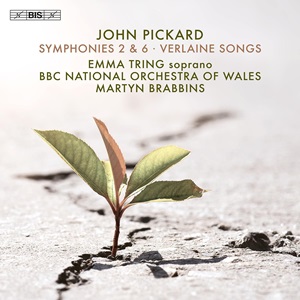
John Pickard (b. 1963)
Symphony No. 2 (1985/1987)
Verlaine Songs (2019/20, orch. 2022)
Symphony No. 6 (2021)
Emma Tring (soprano)
BBC National Orchestra of Wales/Martyn Brabbins
rec. 2023, Hoddinott Hall, Cardiff, UK
BIS BIS-2721 SACD [72]
John Pickard admits in his booklet essay (from which I will quote, with thanks) that he has ‘spent more time listening to and thinking about symphonies than any other kind of music’. This might be why he could, even at an early age, think large-scale and symphonically.
In Symphony No.2, quite early on we become aware of the shape of the work. Its one movement falls, says the composer, into six sections. They are marked by subtle tempo changes but end with the dark, slow one with which the work started. It not only grows in terms of tempi but in activity and tension. Pickard comments that he was grateful to the orchestra ‘for their time-honoured tolerance of the display of youthful excess during the recording sessions’.
This is really young man’s protest music. I am not sure if I like it – and I normally enjoy Pickard’s works. Perhaps it also shocked the composer. He also admits that the plan which he had devised, under the influence of his then teacher Louis Andriessen, fell apart as his instinct led him elsewhere. The starting point for the piece was a realisation of the resurgence of nature in the most devasting of circumstances, such as Hiroshima, but he emphasises that this is in no way a descriptive work.
Symphony No.6, a little easier to come to terms with, has two movements, basically fast then slow, eleven and sixteen minutes. It was composed at that difficult time when the third Covid lockdown was announced in the UK. Not surprisingly, the first movement is full of anxiety, and I would say anger – what I think we all felt. The harmonic language reminded me in some ways of Pickard’s best-known work The Flight of Icarus (review).
The slow movement builds into a funeral march of some power. This can be heard as a memorial to all those thousands who died at that time, even if Pickard never says so. Even more relevant are the closing five minutes. He says that this is ‘nature music’, and we are reminded how we had to turn to the natural world for comfort and respite. The work ends under a cloud of deep gratitude for the beauty of our world. I wonder if this could truly be considered a Covid Symphony.
Between these so different symphonies come the Verlaine Songs, quite a contrast. The style is eclectic. Soprano Emma Tring’s wonderful virtuosity and clear vocal quality helped to inspire Pickard. The orchestration of Chanson d’automne and Spleen is full of what one might call ‘French sensibility’ and subtle shading of the vocal line. Marine is a storm with suitably violent textures (which at no point, here or in the other songs, obscure the voice). Le squelette, rather grotesquely orchestrated, concerns two drunks who meet a skeleton with its ‘hostile sneer’. L’heure exquise is lyrical and romantic, almost Mahlerian in its use of strings. Le soleil d’or is an ecstatic song to the golden sun. This gorgeously impressive song cycle is well worth the price of the disc alone.
John Pickard has been most favourably treated here, not only by the orchestra, Emma Tring and Martyn Brabbins, but by BIS. They have supplied a vivid recording and useful booklet notes, with good translations of Verlaine’s poems.
Gary Higginson
Previous review: Hubert Culot (June 2024)
Buying this recording via a link below generates revenue for MWI and helps us keep free access to the site



















